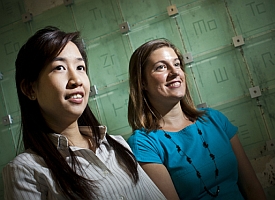Materials scientists at Massachusetts Institute of Technology devised a process for growing and merging nanoscale metallic crystals to create alloys that can withstand the stress of high temperatures. MIT graduate students Tongjai Chookajorn and Heather Murdoch (pictured left), with faculty advisor Christopher Schuh, discuss their methods in this week’s issue of the journal Science; paid subscription required.
Shrinking grains to the nanoscale — one nanometer equals one billionth of a meter — can strengthen a metal, but at high temperatures those nanocrystalline grains will grow and merge together, losing stability and softening the metal. Murdoch developed a theoretical method to identify combinations and proportions of metals that yield stable alloys. That method focused on the boundaries of of the nanoscale grains, calculating the stability of granular boundaries on hundreds of combinations of metals.
Based on Murdoch’s calculations, Chookajorn then synthesized a test material of tungsten and titanium [sponsored link], and demonstrated that the new metal has the stability and properties that Murdoch had predicted. That tungsten-titanium material, with grains of 20 nanometers across, remained stable for a full week at a temperature of 1,100 degrees Celsius. Industrial processes such as sintering, where metals in a powdered state are formed into shapes, submit metals to heat at those temperatures.
The tungsten-titanium alloy created in the lab, with its high strength and stability, has a number of potential applications such as protective devices for industrial machinery and vehicle armor. The process for creating the alloy, however, can be extended to create alloys with other desirable properties, such as corrosion resistance. In addition, the methods to identify the most likely candidates for alloys can apply thermodynamic calculations rather than physical trial-and-error tests. “We can calculate, for hundreds of alloys, which ones work, and which don’t,” says Murdoch.
In a commentary in Science, materials science and engineering professor Julia Weertman of Northwestern University calls the issue addressed by Chookajorn and Murdoch, a “particularly vexing problem” among materials scientists, where attempts “to prevent grain growth in a nanocrystalline metal by alloying have been hit and miss ….” Weertman notes that in Chookajorn and Murdoch’s research, “A rational method is made available to design nanocrystalline alloys that meet operational requirements, even at elevated temperatures.”
Read more:
- Air Force Grant to Fund Research on Nanomaterials Shaping
- Laser Techniques Manufacture 3-D Aluminum Composite Parts
- Natural Lightweight Material Exhibits Strength, Toughness
- National Lab Developing Alternatives to Rare Earth Materials
- Company, University Partner on Steel Manufacturing Process
* * *


 RSS - Posts
RSS - Posts
[…] Process Developed for Stronger Alloys at High Temperatures […]
[…] Process Developed for Stronger Alloys at High Temperatures […]